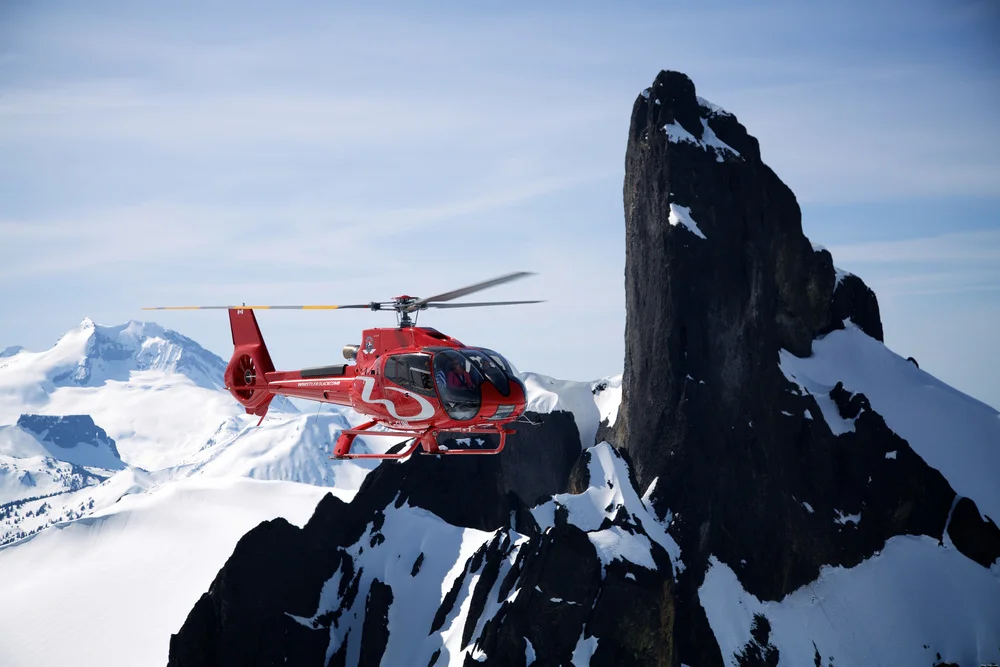Posted on August 21st, 2017; Lisa Gordon
It’s late in the afternoon when a worker at a remote mining operation 120 kilometers northwest of Squamish, British Columbia, goes into cardiac arrest.
From left: Jordan Lawrence, Dr. Greg Haljan, Paul Windsor and Miles Randell were at the 2017 Abbotsford International Airshow to promote TEAAM, a new helicopter emergency medical service that will be based in Squamish, British Columbia. In collaboration with Blackcomb Helicopters, the organization aims to deliver advanced medical care to patients in remote sites that are beyond the mandate of the province’s current air medical providers. Lisa Gordon Photo
The mine is isolated; the supervisor calls for help, but a BC Ambulance Service (BCAS) ground vehicle will take more than two hours to navigate the rough terrain before arriving at the site.
A helicopter dispatch is unlikely, simply because the mandate of the BCAS prevents its aerial emergency responders from landing at remote, unprepared locations.
The worker’s only hope for a speedy evacuation lies with a volunteer helicopter search-and-rescue (SAR) organization, which would then be required to transfer the patient into the care of a BCAS air ambulance or land-based unit for delivery to the appropriate medical facility.
But while these organizations provide a dependable service in the province, they, too, are not mandated to respond to isolated worksites.
The patient in this fictional scenario has little chance of survival. Waiting two hours for a land ambulance while in cardiac arrest is a story that is unlikely to have a happy ending.
It’s this type of situation that is highlighted in a February 2017 report from the B.C. Forest Safety Ombudsman, Roger Harris.
The document, titled Will It Be There – A Report on Helicopter Emergency Medical Services (HEMS) in BC, delivers a critical analysis of the province’s emergency helicopter response capability and takes the position that the location of an injured worker — or indeed, any citizen — should not impact the timeliness and quality of emergency medical attention they receive.
In fact, the report found that HEMS service in B.C. is inferior when compared to other jurisdictions with similar geography, such as Washington State or Alaska, where 99 percent of the population is within a 60-minute response time to a Level 3 trauma center.
The Ombudsman’s findings are no surprise to Miles Randell and Paul Windsor.
Both are long-time experienced paramedics with BCAS. In January 2017, just a month before the report was released, the two men decided to collaborate on the creation of a not-for-profit entity that would deliver advanced medical care to patients located in British Columbia’s most isolated regions.
“We realized we needed to go out on our own, create our own society, and prove the need was there,” Randell told Vertical during an interview at the 2017 Abbotsford International Airshow.
A TEAAM is born
Randell and Windsor approached Blackcomb Helicopters in the town of Squamish, where they planned to base their new response unit.
Immediately, Blackcomb management saw the vision behind the paramedics’ proposal and agreed to support the founding of Technical Evacuation Advanced Aero Medical, or TEAAM.
“They were so interested in the program that they jumped in with both feet and have done everything they can to support us,” said Randell, who is president of the new organization.
Windsor, TEAAM’s vice president, agreed. “They’ve gone above and beyond to help us, providing training and hoisting expertise, and donating flight time for training and for the promo video we shot.”
Randell acknowledged that TEAAM’s founding comes at an opportune time, when the province’s Forest Safety Ombudsman has focused public attention on the provision of HEMS in British Columbia.
The new service will be getting off the ground thanks to a number of significant industry partnerships.
“We’re getting pretty solid financial support from the energy sector,” confirmed Randell. “We’re also building support in the forestry and marine sectors and approaching the provincial government for funding as well. We would like to build it like a P3 model, so 33 percent corporate [revenue], 33 percent government, 33 percent donations.”
He said it will cost about $2.5 million annually to provide one dedicated on-call aircraft, a Blackcomb Helicopters EC-135 T2+. The helicopter is equipped with the latest advanced life support medical care equipment, including hoist and long-line capability.
“Air ambulance and volunteer SAR both do a fantastic job, but they’re not equipped to get to those remote settings where a helicopter can’t set down,” said Randell. “Our goal is to get there, provide that advanced medical care, and then transport the patient to air ambulance or, with permission, to a medical facility.”
TEAAM building
TEAAM is currently hiring aircrew and advanced medical providers.
Today, there are eight board members and a total of 11 people involved in the initiative, which is set to launch on Sept. 1. The goal is to expand that number to 25 staff before that date.
Randell and Windsor anticipate that most calls for help will originate from the area northwest of Squamish — a remote section of the province that is home to many resource development operations. However, they will also conduct marine operations for industry partners operating in the straits between the British Columbia mainland and Vancouver Island.
The TEAAM concept has been attracting a lot of attention, including from Royal Canadian Air Force (RCAF) search-and-rescue technicians, several of whom visited the organization’s display at the Abbotsford Airshow. Although the model is different from the public service provided by the RCAF, everyone sees the business case.
There’s no doubt that Randell and Windsor are passionate about TEAAM.
“We’re so excited!” said Windsor, shouting over the noise of an aircraft flying overhead at Abbotsford. “Now, people in remote settings and workers will get advanced care and top of the line technology to patient-side quickly and efficiently, where it just doesn’t happen today.
“That’s what drives us to do this. We can save lives.”

